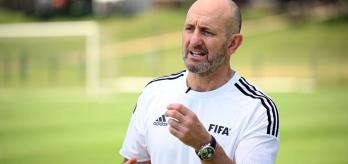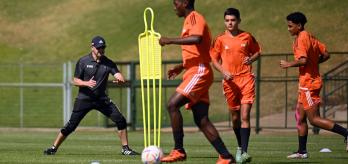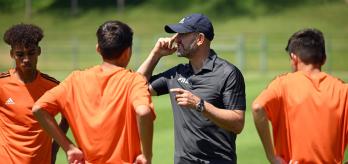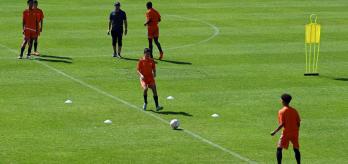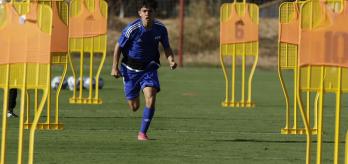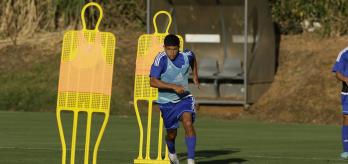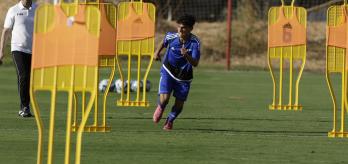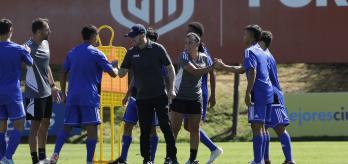Appropriate for the early stages of technical work, the drills in this session place an emphasis on ball contact for concentrated periods. As preparation progresses, the drills are carried out less frequently and eventually become part of a technical warm-up within the overall training plan.
Training perspective
The drills are designed for a minimum of three participants, with one working player assisted by two ball-serving players performing a succession of exercises with the football for specified periods. This three-player approach is essential when preparing players to return from injury (see Training perspective – article 1 for an introduction to this series).
Emphasis and methodology
The drills target technical coordination in tight spaces (5-15m) with a focus on tempo and technical fluidity. The working player is active within the grid, while the other participants and a ball-serving player/coach provide the anchor points for the movement and passing orientation. Specific emphasis is placed on out-and-back rotations, with differing inbound and outbound movement and passing sequences. The drills are more dynamic than in the first session and include running with and without the ball and receiving it on the move. The drills are all technically balanced and designed as such in several movement planes. Overall, the methodology places a concentrated loaded exposure on a variety of simple functional techniques and passing patterns with distances that are appropriate for early-phase technical work.
Overall objective
The drills aim to sharpen players’ coordinative pathways and technique following brief injury lay-offs and to reboot and recondition the same footballing pathways following longer spells on the sidelines. There is a particular emphasis on receiving and passing the ball while on the move.
Implementation
Aimed at all on-the-field practitioners responsible for helping players return from injury, the drills in this session form part of an overall training programme aimed at providing a variety of technical-physical training solutions (with a stronger emphasis on the technical elements) for all phases of recuperation. Practitioners can select individual drills or entire sessions to fit their overall training plans for players in their care.
The drills in this session can also be used for:
- small training groups of 3-5 players;
- technical recovery sessions from high intensity workloads or match play;
- dedicated non-contact technique and passing quality; and
- technical-physical potentiation and warm-up
Workload training metrics
A simple table showing the duration of the drills, the number of sets and the work-to-rest ratios can be found here:
 2.jpg)
Set-up for all drills
Grid distances
-
Set up a 15x15m outer grid using flat discs/cones (a+b)
-
Set up a 3x3m inner grid using four pole/mannequin gates (c+d) at midpoint of (a+b)
-
One to two sets
-
2-4 minutes, work-recovery intervals, dependent on the number of players
-
Work-to-rest ratio of 1:2
-
Drills 1-3 are technically balanced, drill 4 requires left and right sets
-
Minimum of 2 working players + 1 ball-serving player
-
Maximum of 4 working players + 1 ball-serving player
-
Allow players a familiarisation period before starting the first set
-
Encourage players to use their left and right foot to pass and perform their technical movements
-
The duration of drills is to be calculated while the ball is in play; stop the watch if the rhythm of the drill is interrupted
Drill 1: Move away on the half turn to receive and play forwards
-
Player1 shifts the ball forwards and runs between the mannequin gates to play a straight pass to the server, then moves quickly wide of the gates to receive a return pass
-
The server plays a diagonal pass into the path of player 1
-
Player 1 moves the ball forwards and plays a diagonal ball into the path of the next player
-
The sequence is then repeated in the opposite direction
-
For technical balance, players should be encouraged to use their right foot when passing from the right side of the mannequin gates and their left foot when passing from the left side the mannequin gates.
-
To reinforce good awareness habits, players should be encouraged to look up and identify the next player in the sequence before receiving the pass, and to get their head up before playing the next pass.
Drill 2: Lateral quick feet technique, move away into space
-
Player 1 shifts the ball forwards between the mannequin gates to play a straight pass to the server
-
Upon receiving the return pass, player 1 shifts the ball wide of the mannequin gates and plays a short, angled pass to the server before moving quickly back to the centre position to receive a second return pass
-
Player 1 then shifts the ball wide of the opposite gate and plays another angled pass to the server before quickly moving wide to the midpoint of the grid to receive a final return pass from the server
-
Finally, player 1 plays a diagonal pass into the path of the next player
-
The sequence is then repeated from the starting position
-
For technical balance, players should be encouraged to use their right foot when passing from the right side of the mannequin gates and their left foot when passing from the left side the mannequin gates.
-
To reinforce good awareness habits, players should be encouraged to look up and identify the next player in the sequence before receiving the pass, and to get their head up before playing the next pass.
Drill 3: Play forwards, move into space, turn, and play diagonal
-
Player 1 plays a diagonal pass into the path of player 2, who should be on the half turn
-
Player 2 shifts the ball forwards and plays a straight pass to the server, before moving quickly into the space wide of the mannequin gates to receive a return pass
-
The server plays a diagonal pass into the path of player2
-
After shifting the ball into the space in front of them, player 2 plays a diagonal pass so that the sequence can alternate from the opposite corner of the grid
-
Minimum player numbers: 3 players + 1 server
-
For technical balance, players should be encouraged to use their right foot when passing from the right side of the mannequin gates and their left foot when passing from the left side of the mannequin gates.
-
To reinforce good awareness habits, before receiving the diagonal pass, player 2 should be encouraged to look up and identify the next player in the sequence, and to get their head up before playing the next pass.
-
NB: For technical balance, the ball must rotate to the opposite corner for each new sequence to get under way.
Drill 4: Turn and switch the play, move into space, turn and switch the play
-
Player 1 plays a diagonal pass into the path of player 2, who should be on the half turn
-
While moving away and stepping backwards on the half turn, player 2 turns out and slots an angled pass to the server
-
Player 2 then scampers between the mannequin gates and across to the far side of the grid to receive a return pass from the server
-
Player 2 then turns out and plays an angled pass for the next player to repeat the sequence
-
For technical balance, players should be encouraged to use their right foot when passing from the right side of the mannequin gates and their left foot when passing from the left side the mannequin gates.
-
To reinforce good awareness habits, before receiving the diagonal pass, player 2 should be encouraged to look up and identify the next player in the sequence, and to get their head up before playing the next pass.
-
The diagram shows the play being switched from left to right. A second set in which the play is switched from right to left is required for technical balance.









